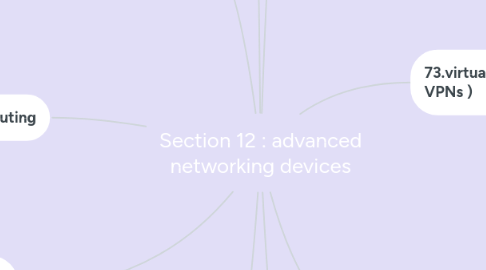Section 12 : advanced networking devices
von Emtenan saad

1. 74.introduction to VLANs
1.1. - VLAN split one big broadcast domain and breaks it up into two or more smaller broadcast domains
1.2. - There are 2 types of switches:
1.2.1. - 1- unmanaged switches are simple devices that only do switching
1.2.2. - 2- managed switches offer other features such as VLANs
1.2.2.1. -
1.3. - The managed switches have IP addresses that enable connection and configuration
2. 75. Inter VLAN routing
2.1. - inter VLAN routing is in essence a virtualization of the function of a router that’s put onto higher end switches with intervening routing turned on
2.2. - Inter VLAN routing acts like one or more virtual routers
3. 76.interfacing with managed switches
3.1. - the managed switches require configuration
3.2. - The console port can be used to connect to and managed a switch or router
3.3. - Cisco router use an operating system called IOS
4. 78. Port mirroring
4.1. - port mirroring enables the traffic flowing through one pot to be monitored on another port
4.2. - Port mirroring is configured on a switch by providing a source port and a destination port
5. 79. Quality of service
5.1. - traffic shaping its generic term that simply means control the traffic based on all kinds of stuff and control traffic based on the type of service that’s coming in or out of the system or based on IP addresses So you can control traffic based on any criteria and the best way and most common way to control traffic is by quality of service
5.2. - Quality of quality of service is simply mechanism by which we can perform traffic shaping
6. 72.client/server vs peer to peer
6.1. - Microsoft LAN introduced peer to peer and peer to peer simply meant that any computer could be a client or a server
6.2. - Action on the internet follow the clien/server pattern
6.3. - BitTorrent is a popular perr to peer networking tool
6.4. - In classic peer to peer network each machine could act as both a client and a server , now days The terms are used more in the sense of a web client accessing a web server
7. 73.virtual private networks ( VPNs )
7.1. - challenge in getting a remote computer to be part of LAN , and the LAN most likely uses private IP addresses
7.2. - VPN create a tunnel between a client computer and some endpoint which is usually a router
7.3. - VPN allow that tunnel to create the connectivity between what we call the two endpoints
7.4. - Client to site VPN connect a remote computer to a local network
8. 77.port bonding
8.1. - port bonding have multiple names like : link aggregation channel bonding port , port trunking , nick trunking , nick teaming
8.2. - Port bonding is a process of taking two ports on each devices and they’re going to work together as a team and in essence they will act as one single higher speed port
8.3. - Use LACP for the trunking protocol
9. 80. IDS vs IPS
9.1. - intrusion detection systems detect and report possible attacks to the administrators
9.2. - Intrusion prevention systems run inline with network and act to stop detected attacks


